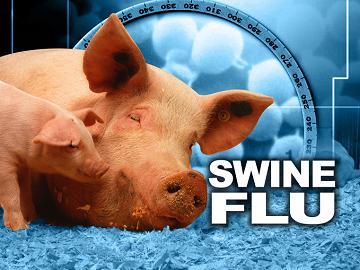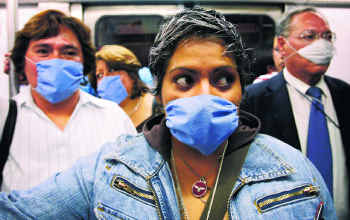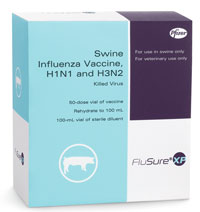Posts Tagged ‘au’
Swine Flu and You!
Posted on: April 28, 2009
- In: health | Uncategorized
- 6 Comments
Swine Flu / Swine Influenza – An Epidemic

The bloody swine influenza A (H1N1) virus that has infected humans in the U.S. and Mexico is a novel influenza A virus that has not previously been identified in North America. This swine flu virus is resistant to the antiviral medications amantadine (Symmetrel) and rimantadine (Flumadine), but is sensitive to oseltamivir (Tamiflu) and zanamivir (Relenza). Investigations of these cases suggest that on-going human-to-human swine influenza A (H1N1) virus is occurring.

Symptoms of Swine Flu?

Although uncomplicated influenza-like illness (fever, cough or sore throat) has been reported in many cases, mild respiratory illness (nasal congestion, rhinorrhea) without fever and occasional severe disease also has been reported.
Other symptoms include vomiting, diarrhea, myalgia, headache, chills, fatigue, and dyspnea.
Conjunctivitis is rare, but has been reported. Severe disease (pneumonia, respiratory failure) and fatal outcomes have been reported with swine influenza A virus infection.
The potential for exacerbation of underlying chronic medical conditions or invasive bacterial infection with swine influenza A virus infection should be considered.

Infectious Period
Persons with swine influenza A (H1N1) virus infection should be considered potentially contagious for up to 7 days following illness onset. Persons who continue to be ill longer than 7 days after illness onset should be considered potentially contagious until symptoms have resolved. Children, especially younger children, might potentially be contagious for longer periods. The duration of infectiousness might vary by swine influenza A (H1N1) virus strain. Non-hospitalized ill persons who are a confirmed or suspected case of swine influenza A (H1N1) virus infection are recommended to stay at home (voluntary isolation) for at least the first 7 days after illness onset except to seek medical care.
Interm Recommendations
For clinical care or collection of respiratory specimens from a symptomatic individual (acute respiratory symptoms with or without fever) who is a confirmed case, or a suspected case (ill close contact of a confirmed case) of swine influenza A (H1N1) virus infection:
Infectious Period
Persons with swine influenza A (H1N1) virus infection should be considered potentially contagious for up to 7 days following illness onset. Persons who continue to be ill longer than 7 days after illness onset should be considered potentially contagious until symptoms have resolved. Children, especially younger children, might potentially be contagious for longer periods. The duration of infectiousness might vary by swine influenza A (H1N1) virus strain. Non-hospitalized ill persons who are a confirmed or suspected case of swine influenza A (H1N1) virus infection are recommended to stay at home (voluntary isolation) for at least the first 7 days after illness onset except to seek medical care.

Case definitions
A confirmed case of swine influenza A (H1N1) virus infection is defined as a person with an acute respiratory illness with laboratory confirmed swine influenza A (H1N1) virus infection at CDC by one or more of the following tests:
* real-time RT-PCR
* viral culture
* four-fold rise in swine influenza A (H1N1) virus-specific neutralizing antibodies
A suspected case of swine influenza A (H1N1) virus infection is defined as a person with acute febrile respiratory illness with onset within 7 days of close contact with a person who is a confirmed case of swine influenza A (H1N1) virus infection.
Close contact is defined as: within about 6 feet of an ill person who is a confirmed or suspected case of swine influenza A (H1N1) virus infection.
* Close contact is defined as: within about 6 feet of an ill person who is a confirmed case of swine influenza A virus infection
Acute respiratory illness is defined as recent onset of at least two of the following: rhinorrhea or nasal congestion, sore throat, cough (with or without fever or feverishness)
Treatment

Antiviral treatment of a confirmed case of swine influenza A (H1N1) virus infection, either oseltamivir (Tamiflu) orzanamivir (Relenza) may be administered. Recommended duration of treatment is five days. These same antivirals should be considered for treatment of cases that test positive for influenza A but test negative for seasonal influenza viruses H3 and H1 by PCR.
How serious is swine flu infection?
Like seasonal flu, swine flu in humans can vary in severity from mild to severe. Between 2005 until January 2009, 12 human cases of swine flu were detected in the U.S. with no deaths occurring. However, swine flu infection can be serious. In September 1988, a previously healthy 32-year-old pregnant woman in Wisconsin was hospitalized for pneumonia after being infected with swine flu and died 8 days later. A swine flu outbreak in Fort Dix, New Jersey occurred in 1976 that caused more than 200 cases with serious illness in several people and one death.
Can I get swine influenza from eating or preparing pork?
No. Swine influenza viruses are not spread by food. You cannot get swine influenza from eating pork or pork products. Eating properly handled and cooked pork products is safe.
What is the best way to keep from spreading the virus through coughing or sneezing?
If you are sick, limit your contact with other people as much as possible. Do not go to work or school if ill. Cover your mouth and nose with a tissue when coughing or sneezing. It may prevent those around you from getting sick. Put your used tissue in the waste basket. Cover your cough or sneeze if you do not have a tissue. Then, clean your hands, and do so every time you cough or sneeze.
What is the best way to keep from spreading the virus through coughing or sneezing?
If you are sick, limit your contact with other people as much as possible. Do not go to work or school if ill. Cover your mouth and nose with a tissue when coughing or sneezing. It may prevent those around you from getting sick. Put your used tissue in the waste basket. Cover your cough or sneeze if you do not have a tissue. Then, clean your hands, and do so every time you cough or sneeze.
What is the best technique for washing my hands to avoid getting the flu?
Washing your hands often will help protect you from germs. Wash with soap and water. or clean with alcohol-based hand cleaner. we recommend that when you wash your hands — with soap and warm water — that you wash for 15 to 20 seconds. When soap and water are not available, alcohol-based disposable hand wipes or gel sanitizers may be used. You can find them in most supermarkets and drugstores. If using gel, rub your hands until the gel is dry. The gel doesn’t need water to work; the alcohol in it kills the germs on your hands.
Recent Comments